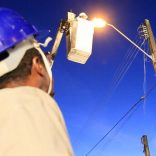Mozambique seeks funding for Mphanda Nkuwa in London
Mozambique: Half of homes have no electricity; solar in 1 in 5 of those that do – INE

FILE - For illustration purposes only .A solar installation in rural Mozambique [File photo: ALER /3E Consulting]
Half of Mozambican families do not have any electricity supply solution at home and of those that do, almost 20% are guaranteed with solar panels for self-consumption, according to data from the National Institute of Statistics (INE) of Mozambique.
According to the Survey on the Impact of Access to Sustainable Energy in 2022, completed this month by the INE, 50.1% of the more than 6.3 million households in the country had access to an electricity connection.
Of this total, 32% had access through the national electricity grid and 18.1% through other sources.
“This means that 49.9% of households are without connection to the grid or other electricity solutions, a situation that is more serious in rural areas (86.8%), provinces of Tete (84.7%) and Zambézia (83. 3%)”, reads in the INE report.
It adds that “the few households with electricity in the rural area” have greater access through solar energy (85.3%), rechargeable batteries (74.9%) and dry cell batteries (71.4%) compared to the urban area, that uses electricity from the national grid (72.2%) and an electric generator (58.3%).
In families that have access to electricity at home from sources other than the national or local grids, solutions are dominated by dry cell batteries (47.1%), followed by solar energy for self-consumption (19.4%). in addition to rechargeable batteries (1.8%) and generators (0.5%).
On Mozambique’s energy profile, INE refers that the country has an installed electricity production potential of 2,966 Megawatts, with hydropower as the main source of production and renewable energy representing 77% of total capacity.
“Production from natural gas is the main source of non-renewable energy, contributing with about 10% of global production. In Mozambique, 50% of the energy produced is exported to neighbouring countries, with the Republic of South Africa being the main destination, with a weight of around 80.0% of exports”, points out the INE survey.













Leave a Reply
Be the First to Comment!
You must be logged in to post a comment.
You must be logged in to post a comment.